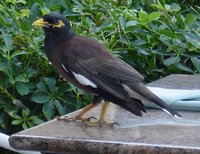Common Myna
|
|
| Common Myna Conservation status: Lower risk | ||||||||||||||
|---|---|---|---|---|---|---|---|---|---|---|---|---|---|---|
| | ||||||||||||||
| Scientific classification | ||||||||||||||
| ||||||||||||||
| Binomial name | ||||||||||||||
| Acridotheres tristis (Linnaeus, 1766) |
The Common Myna, Acridotheres tristis, is a myna, a member of the starling family. This bird is a common resident breeder in tropical southern Asia from Afghanistan to India and Sri Lanka. It is also known as the Indian Myna.
It has extended its range into southeast Asia, and has been introduced widely elsewhere, including South Africa, Hawaii, North America, Australia and New Zealand.
This abundant passerine is typically found in open woodland, cultivation and around habitation. The Common Myna builds a nest in hole in a tree or wall. The normal clutch is 4-6 eggs.
These 25 cm long birds have brown body and wing plumage, with large white wing patches obvious in flight. The head and throat are dark grey. The bill, bare skin around the eyes and strong legs are bright yellow. The sexes are similar. Mynas mate for life. They strut in walking, hopping usually only to jump up or down. Their songs include croaks, squawks, chirps, clicks and whistles and they often fluff their feathers and bob their heads in singing. They screech warnings to their mates or other birds in cases of predators in proximity.
Like most starlings, the Common Myna is omnivorous.
Reference
- Birds of India by Grimmett, Inskipp and Inskipp, ISBN 0-691-04910-6

